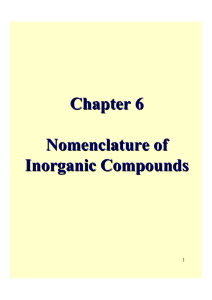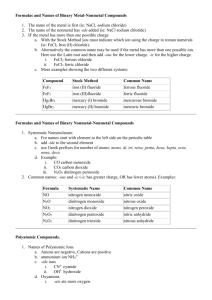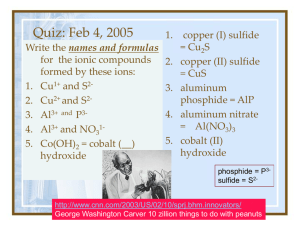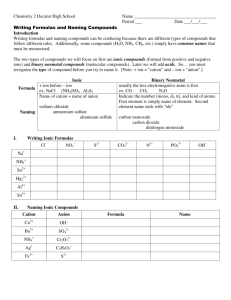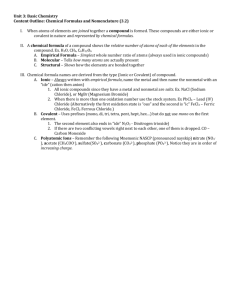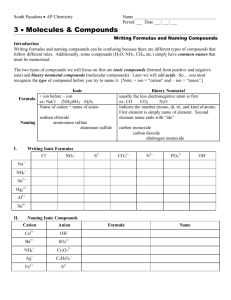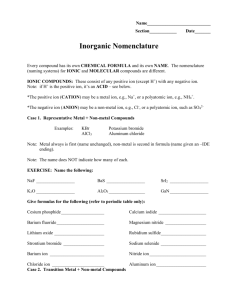Supplemental Nomenclature Powerpoint for
advertisement
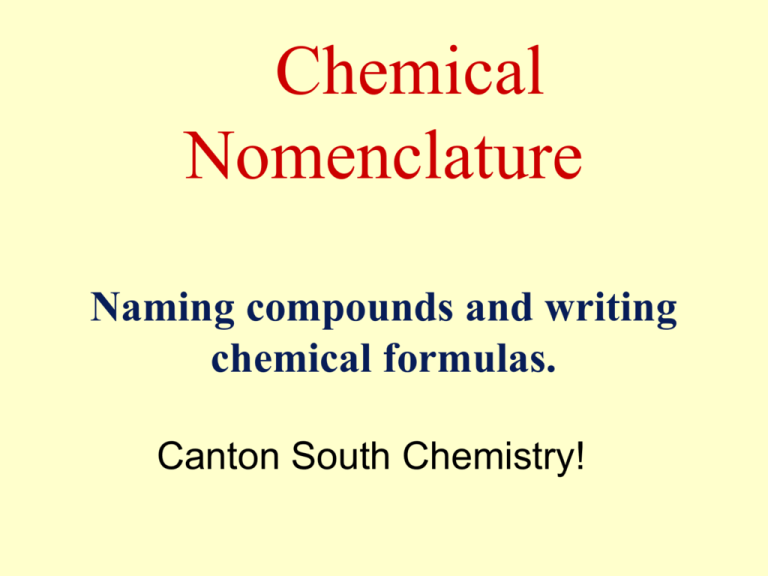
Chemical Nomenclature Naming compounds and writing chemical formulas. Canton South Chemistry! Predicting Charges on Monatomic Ions +1 +2 +3 +4 +5 +2 +3 -4 -3 -2 -1 0 Understanding Nomenclature Nomenclature refers to the process of naming chemicals. Initially the focus is on the most basic rules and ideas involved in the naming of compounds. I. Binary Compounds A binary compound contains just two element 1. The element with the positive charge ( more metallic ), is written first. 2. The element with the negative charge( more non-metallic) is written second Understanding Nomenclature The first • word (metal or positive ion) remains the same word The second word (negative ion) is formed by changing the ending of the element name to “ide”. For example: ex: fluorine changes to fluoride, NaCl KBr and oxygen to oxide sodium chloride potassium bromide 1. Using the rules given , name the compounds listed below. 1. MgO ____________________ 2. CaI2 __________________ 3. BaS ____________________ 4. ZnI2 ______________________ 5. CaO ____________________ 6. Ag2O_____________________ 7. K3P ____________________ 8. AlBr3_____________________ 9. Na3N ____________________ 10. MgS_____________________ Writing proper Chemical formulas. The net charge of the formula must be zero potassium and chlorine = potassium chloride 1+ 1- = 0 K Cl = KCl Crisscross Method simplified method for writing these formulas Calcium Ca2+ Ca2+ 1 2+ Ca2+ 1 and bromide Br1- = = calcium bromide 0 Br12 Subscripts 2Br1- = 0 Ca1Br2 2 **But we don’t write ones!!! CaBr2 Crisscross Method simplified method for writing these formulas aluminum Al3+ Al3+ 2 6+ Al3+ 2 and sulfide S2- = = aluminum sulfide 0 S23 Subscripts 6S2- = 0 Al2S3 3 Al2S3 Using the rule given , give the formula for these compounds 12. sodium chloride ____________13. potassium iodide __________ 14. magnesium sulfide __________15. aluminum bromide__________ 16. strontium oxide ____________ 17. sodium sulfide __________ 18. rubidium phosphide _________19. barium nitride __________ Groups/Families VIIIA IA IIA • 23, 24, 23, 23, 23, 12, 2 • 1, 2 • 24, 13, 12 Cr +1 +2 Mn +2 +3 +2 +4 Fe +2 +3 Co Ni +2 +3 +2 +3 Cu +1 +2 VIIA I-VIIIB +1 +2 +4 -4 -3 -2 +2 +4 +3 +5 +2 Cd +2 multiple charges Pt VIA Zn +3 Ag VA Au Hg +1 +3 +1 +2 -1 0 Type II Binary Compounds (Stock System) Some metallic element are capable of more than one positive charge. We will indicated these with a roman numeral in parenthesis following the name of the positive element. Roman numeral = the + charge iron (II) = 2+ and iron (III) = 3+ ***Used only when:*** MORE THAN 1 POSITIVE CHARGE Type II Binary Compounds (Stock System) Compare iron FeCl2 & and chloride 2+ FeCl3 2- Fe 1 Cl 12 iron chloride 3+ Fe 1 3Cl13 = iron(II) chloride = 0 iron(III) chloride = 0 ***Used only when:*** MORE THAN 1 POSITIVE CHARGE Type II Binary Compounds 4. Name the following compounds. 21. CuO ______________________ 22. PbS lead (II) sulfide ________________________ 23. HgCl ______________________ 24. MnO2 _________________________ 25. Fe2S3 ______________________ 26. SnBr2 ________________________ 27. BiCl3 ______________________ 28. PbCl4 ________________________ Classical or “Old School” The "ous"-"ic" System Another method of indicating metallic ions with more than one charge is: a suffix The suffix -ous is used for the lower charge. while the suffix -ic is used for the higher ionic charge * Chemistry trivia time: In the James Bond movie Goldfinger who was the villian? Auric Goldfinger What was the license plate number on Goldfinger's Rolls Royce? AU3 What was the name of Goldfinger's business establishment? Auric Enterprises ** Mercury's name was changed because hydroargentous and hydroargentic would be just to much to handle “Old School” The "ous"-"ic" System (“old school”) 29. ferric chloride (Stock) ________________________ tin (IV) oxide 30. stannic oxide ________________________ 31. mercuric iodide _____________ SnO2 _____________ ________________________ 32. cuprous oxide ________________________ 33. plumbous sulfide formula _____________ _____________ ________________________ _____________ 34. antimonic bromide _______________________ ____________ 35. aurous phosphide ________________________ _____________ Ternary Compounds It takes “3” or more A ternary compound contains three or more different elements. Ternary compounds usually contain one or more polyatomic ions ( Examples: Fe(ClO4)2 ; NaOH : radicals ). NH4MnO4 When writing the formula – the basic rules apply. Polyatomic ions ( radicals )are treated just like an ion. Determining Names and Formulas of Ionic Compounds Containing Polyatomic Ions Ex: Calcium hydroxide Calcium Ca2+ Ca2+ 1 and hydroxide OH1- = = calcium hydroxide 0 OH12 Subscripts CaOH2 But OH2 = H2O = water !!! ***Parentheses : need to be used whenever more than a single polyatomic ion is needed to balance the charges - in other words if you add a subscript put the polyatomic radical in parentheses. Ca(OH)2 Practice with Polyatomic Ions NH4OH ammonium hydroxide Ba(OH)2 barium hydroxide Fe(CN)3 iron (III) cyanide Zn(C2H3O2)2 zinc acetate ammonium sulfide (NH4)2S plumbous hydroxide Pb(OH)2 ... the `ate chart Polyatomic Ions – they all contain oxygen -3 -2 -1 PO43- SO42- NO3- CrO42- ClO3- CO32- MnO3- ... the `ate chart -3 -2 Please Study Nomenclature Crazy Class Chemistry -1 Manana ? ... the `ate become… `ites – they all lose an oxygen.. -3 -2 -1 PO33- SO32- NO2- CrO32- ClO2- CO22- MnO2- but the charge remains the same ... the `ate; the `ite; now the hypo– subtract another oxygen !! -3 -2 -1 PO23- SO22- NO - CrO22- ClO - CO 2- MnO - and the charge remains the same ... the `ate; the `ite; the hypo.. – lets add an oxygen … the Per- -3 -2 -1 PO53- SO52- NO4- CrO52- ClO4- CO42- MnO4- and the charge remains the same `ate ClO4-1 `ite hypo- per- perchlorate ClO3-1 chlorate ClO2-1 chlorite ClO-1 hypochlorite carbonate versus bicarbonate CO3-2 carbonate Na2CO3 sodium carbonate HCO3-1 bicarbonate NaHCO3 sodium bicarbonate add H+ and drop a negative charge Determining Names and Formulas of Ionic Compounds Containing Polyatomic Ions 36. AlPO4 38. __________ 40. ______________________ lithium cyanide 37. (NH4)2CO3 39. ___________ KClO ______________________ 42. __________ calcium phosphate 43. ___________ 44. __________ ammonium acetate 45. NaMnO4 _______________________ copper(II) nitrate 41. Zn(C2H3O2)2 ______________________ ammonium sulfite _______________________ Naming Covalent Molecular Compounds Nonmetal to Nonmetal ( or to the right of the zigzag red line) Use these Prefixes: mono - 1 di 2 penta - 5 hexa 6 nona - 9 deca – 10 Ex: Greek prefixes to indicate number (never use mono on first) tri - 3 hepta - 7 BF3 boron trifluoride tetra - 4 octa - 8 NO nitrogen monoxide N2O5 dinitrogen pentoxide Naming Covalent Molecular Compounds 1. CO __________________________ 8. diphosphorus pentoxide _________________ 2. PBr3 ______________________________ 9. carbon dioxide _________________ 3. CCl4 ______________________________ 10. selenium trioxide _________________ 4. NCl3 ______________________________ _________________ 11. sulfur hexafluoride 5. SeO2 ______________________________ 12. phosphorus pentiodide ________________ 6. P2O3 _____________________________ 13. sulfur tribromide ________________ 7. NH3 ______________________________ 14. phosphorus hexachloride______________

